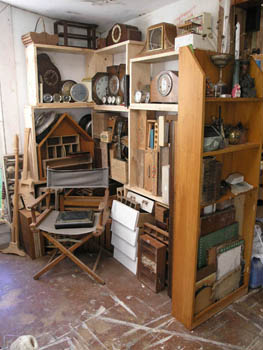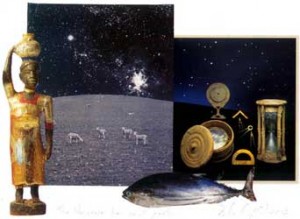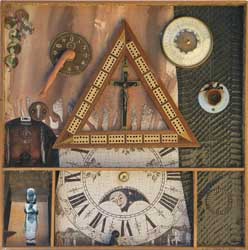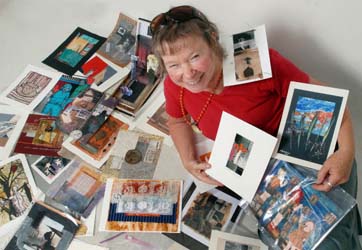January 2008
By Nancy Egol Nikkal

Dale Copeland is an assemblage artist whose studio is located at Puniho, along the Surf Highway in Taranaki, NZ. See her work at http://dalecopeland.co.nz/.
Dale’s Virtual TART website at http://virtual.tart.co.nz showcases a different solo artist each month and links to more than 50 Taranaki artists. It’s an active cyber gallery with an art calendar booked into summer 2009.
I “met” Dale via email in 2000 when I first participated in the 2nd Bakers Dozen international collage exchange. It was a smaller exchange in 2000. Now almost 200 artists from all over the world send 13 collages to Dale in NZ. She sorts and documents everything, set up a brick and mortar gallery show and a cyber show with one work per artist, and returns sets of collages back to every participant. Dale is now the vital energy behind the International Collage Exchange (formerly called Bakers Dozen). If you do collage, please visit http://outofsight.co.nz, read how to participate, and view all the exchanges from 3rd to 9th. There may still be time to send in work for the 10th exchange. The deadline is March 20th, 2008. The 10th International Collage exchange can be viewed during April 2008.
Following is the interview and Dale Copeland’s inspired responses:
Question: You’ve run the Virtual TART website from your home in Puniho, NZ since 1997 (http://virtual.tart.co.nz/). It’s a showcase for the works of more than 50 Taranaki artists.
You’ve organized Taranaki exhibitions around the world. How did the Virtual TART website originate? How has it evolved?
DC: Paul (Paul Hutchinson, painter, Dale’s partner) and I had our own website and it had widened our horizons so much we offered the same opportunity to other Taranaki artists. It was a time when there were very, very few art sites on the Net. I’d long been a bit of a computer geek and taught myself html code to put the website up. It was all very slow, but exciting.
Question: Your personal website (http://dalecopeland.co.nz/) shows your assemblage works. They’re wonderful. You say you have “worked in collage, jewellery, book-making, photography, fabric art and sculpture, but your favoured medium is assemblage (or box art – the careful construction of treasured objects).” You were trained as a mathematician. You were offered the Massey Doctoral Scholarship in chaos theory and now you do assemblage.
DC: All my training is in math & physics. My philosophy of life: “make art while you can, dance till they drop you.”
Question: What roads led you to assemblage?

The Universe Has Small Parts
DC: I’d long collected old stuff … I used to photograph it. When you’re printing big images of an eyeless doll head alongside the skull of a bat and loving the whole process, you’d think it would be a quick and logical move to start using the actual objects instead of just photos of them. But it took me years! A good feeling when I finally got there though.
Question: You say: “I find junk and see treasure. I keep things for years until they find their place.” What kinds of materials and objects get incorporated into your assemblage works? How do you find the objects that become the assemblage? Everyone loves to see an artist’s workspace. Please describe your studio and your treasure trove of materials.
DC: My studio: somewhere between a junk shop, a wizard’s lair, your grandfather’s old shed, a housewife’s horror and the contents of a little boy’s pockets! It takes years to accumulate enough stuff so that whatever you’re making, whatever you need will be in there somewhere.
Question: Describe your work. Is there a special way you start a work? Do you work in series?
DC: It seems necessary to play. To give myself the freedom to play, with no expectation or demand for finished results. To pick up a piece of treasure and wander around trying it with different things, in different boxes, waiting to see if it feels at home somewhere, waiting to see if it begins to tell its story. It’s as much a state of mind as anything.
Question: You enjoy travel and show your work internationally. What was the most significant exhibition you’ve organized (or participated in)? What was the most amazing art trip? What advice would you offer to artists who want to travel and exhibit art internationally?
DC: I’ve been lucky. And also perhaps rash enough to seize opportunities as they flutter past. My art has taken me to New York & Paris & Berlin & Bulgaria & Mexico & Canada. And it’s traveled without me to Japan and England and different parts of USA.
One trip, which turned out to be absolutely wonderful but had me worried at first, was the trip to Bulgaria to a collage symposium. I’d received an email written in French, which seemed to say that if I could get myself to the airport in Sophia, Bulgaria on 1st April then all would be taken care of. I raised the money for the flight and stood in the Sophia airport alone and with no knowledge of the language for 1½ hours, thinking I’d fallen for a very elaborate April Fools’ joke. It was, eventually, great. A big group of artists working at the art school in Plovdiv for a couple of weeks, staying in a Renaissance museum (I kid you not), with exhibitions and meals and daytrips all organized. Fabulous time. Most spoke only Bulgarian. One also spoke French, and one spoke French and English. So it was a 3-way translation coming and going. What hit me most was the deep respect with which artists and art are treated. At the exhibition they had dignitaries making speeches, TV cameras, an art historian giving a detailed analysis of all the works hanging there, and a crowd of people who were genuinely interested in looking at the things rather than (as here) chatting among themselves and having supper.

Rich Man’s View
Advice? Just do it. If you want. Every time I come back I say “never again” … the long, long flights from New Zealand to anywhere are unpleasant, and I begrudge the time away from my own studio. But some places I have loved and I feel richer for having been there.
And of course the art has traveled worldwide through the Internet … we’re so fortunate to be living here and now. It used to be that your greatest ambition as an artist in a remote part of the world that you might get an exhibition in the nearest town. How things have changed.
Question: You organized the exhibition Assemblage 100 to celebrate the centenary of the birth of Joseph Cornell on Christmas Eve 1903 (see the exhibition at http://outofsight.co.nz/Cornell/exhibit/exhibit.htm). You produced an exhibition catalog (see http://outofsight.co.nz/Cornell/catalog.htm). What ideas led to the Assemblage 100 exhibition? Cornell is one of the most significant 20th century artists in assemblage. How has Cornell inspired your own work?
DC: I remember the excitement I felt when I first saw Joseph Cornell’s work, the feeling that I wasn’t alone.
Then in early ’93 I realized that it was nearly the centenary of his birth and that I should mark the occasion. So I invited 12 good assemblage artists I’d ‘met’ over the Net to send work to New Zealand, and organized exhibitions in galleries here. It was originally to be in just one gallery but then other galleries were very easily persuaded to take it. And the works were too good to just let go so I put the illustrated catalog together. I’m very pleased with it, the printer did a great job with all the images. Inspiration? I’m very conscious that Cornell made ‘clean’ assemblages. Not cluttered. So every now and again I have to remind myself that less is best. He had a superb eye.
Question: I’d like you to talk about the International Collage Exchange (originally called Bakers Dozen). I think it’s an extraordinary exhibition and recommend the exchange to all collage artists. Please talk a little bit about the exchange.
DC: Sure thing. Artists each send 13 small (about 8” X 10”) collages. No theme, no restrictions on methods or style. One from each artist is offered for sale on the Net and from an exhibition in New Plymouth, New Zealand (30% commission taken). One other from each artist goes on the Net permanently and goes to an art institution somewhere in the world. This year it’s Amarillo in Texas. In the past the collection has gone to ArtColle in France, to a collection in Mexico, to tertiary art institutes in Australia, New Zealand, North Carolina. The other 11 (or 12 if your work doesn’t sell) are exchanged. I try to make the exchanges between comparable working artists. Difficult, probably impossible to do perfectly, but I try.
Question: The 3rd, 4th, 5th, 6th, 7th, 8th and 9th International Collage exchanges are archived at http://outofsight.co.nz with details for taking part in the upcoming 10th collage exchange (13 works due by March 2008). I understand you’ve already started receiving artist’s packages. It must take an incredible amount of time to sort, select works, do the digital imagery and prepare the online exhibition, and the brick and mortar exhibition and sale. Do you have help? How do you do it?
DC: It’s a huge job. Last year there were 188 artists from all around the world. 13 collages each, do the math. I enter them all in a database, so artists can tell where each of the works has gone. Two from each artist have to be scanned and the pages written for the website. Once the show opens on 1st April it’s very busy dealing with all the sales that come in by email as well as from the gallery. And hanging the show … yes, it’s all a stupid amount of work. But the benefit is that I get to see a huge amount of collage art and I get first pick in the exchange process! I’ve built up a stupendous collection in the years I’ve been running the exchange. It will be donated to PukeAriki Museum here in New Plymouth when I die. They’re excited about that (but far too polite to tell me to hurry up.)
Help? Yes, I’m so pleased. In previous years an artist has occasionally come to help me with the sorting process, helping keep track of which collage goes where. This year I employ Anne Holliday, a very good painter, to come out here every Sunday morning. She pencils the identifying numbers on the back of each collage, and then scans the two collages from each artist while I’m doing the database and website-writing stuff. She’s an excellent help. She’s also been scanning all the collages in my own collection as I’m planning to have a book made of a big selection of them. It makes a huge difference having her assistance.
The deadline isn’t until late March. It’s still January as I write this, and we’ve had 27 packages already. It’s good being able to start early as it will become very hectic in a few weeks.

Dale Sorting Collages
Question: How has the collage exchange changed over the years ?
DC: Many more people are taking part – from extremely good artists with their own distinctive style to those who’ve perhaps been to a workshop, and those who are just starting. There’s an enormous range of styles and confidence.
Collage is taken more seriously as a medium in Europe than here. I think we’re changing that. People now look forward to the opportunity to buy work for their collections.
Question: I think it would be fun for people to hear your thoughts about some of the works that arrive for the exchange. What were the best, the most problematic, and the zaniest materials (or packages) that arrived? Did the postal service lose or decline any packages? What’s the best way for an artist to pack the entries?
DC: I ask for collages no bigger than the A4 size, and flat enough to make packing the return parcels easy. But you know what artists are like. The most difficult to handle were some on wood wrapped in spiky wire netting! In the exchange I tried to make all of those go to New Zealand artists so I could hand-deliver them rather than try to send by post. And some people send really large-sized work. Too big to scan so I have to photograph them, too big to put in envelopes for return to other artists, or to fit in the boxes for sending the collection off to the art institute. Inventive packing is needed or, again, hand-delivering in New Zealand. I don’t like to be too dogmatic about rules, as sometimes there are wonderful exceptions. L.t.dougherty from Canada sent 13 book-box collages and they were wonderful. The size of a hardback book, they opened to reveal pop-up collages that were really exciting. Rigid rules about thickness would have prevented me seeing those delights.
Padded envelopes are most people’s choice of posting method, but I have a preference for envelopes that are padded, not with bubble plastic, but with that shredded paper fluffy stuff. Why? Because I strip them apart and use the fluff to make paper concret for sculptures! It sure beats tearing up newspapers and putting them through the blender.
I’ve had just about every sort of box and package. I ask people to write a low value if they have to fill in a Customs form as otherwise the package gets held up a bit at Customs.The postal service hasn’t lost or rejected anything. The Ministry of Agriculture gets a bit fussy about plant material so they occasionally hold hings back at Auckland airport and fumigate them, but they get here eventually.
I think I’m the highlight of the rural postie’s year as he fights his way through our patch of jungle every day to leave great piles of boxes on the verandah.
Question: How has TV coverage in NZ, and one million hits on the website changed public awareness of the collage exchange?
DC: Public awareness, yes that’s important, and it’s good for collage as an art genre that so many people look forward to April and to seeing the new exhibition. And artist awareness and participation, that’s great. Growing every year, and some fantastic artists taking collage seriously as a medium. But you know what pleases me as much as anything? There’s an elderly artist living in Wellington with 25 cats, hasn’t got a computer so has never seen the show online (I send her a printout of the front page) but looks forward to taking part each year and always writes me a letter saying it’s absolutely the only outlet for her art that she has any more. For that, I’ll keep it going.
Dale says there are some exceptionally good collage artists in the world and she’s really happy that they have been taking part in this exchange for years – she adds: it’s like greeting eagerly-awaited friends when their packages arrive.